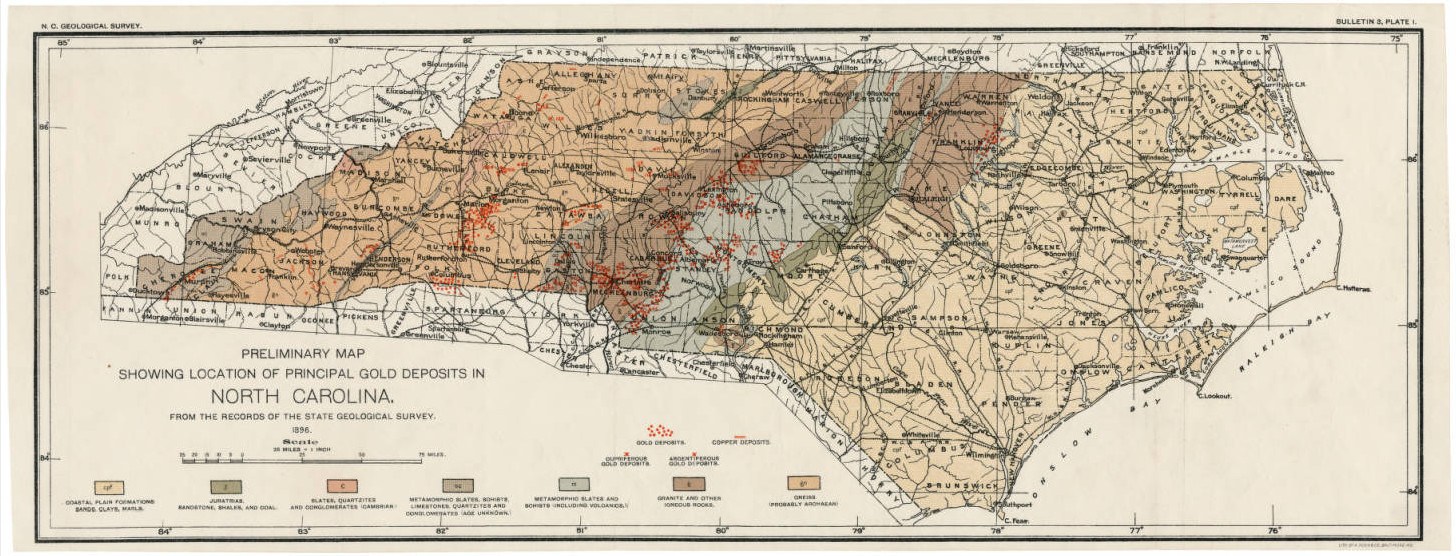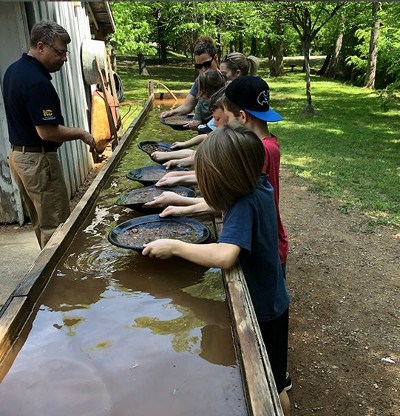Published on
North Carolina was the site of the very first gold rush in America. The gold rush here has long ended, but it's still a good state for individual prospecting. Recreational panning of its rivers and streams often turns up gold that went unnoticed by earlier prospectors.
History
Gold was first reported in North Carolina by John Reed, who discovered a 17-pound nugget in Cabarrus County in 1799. Many additional gold discoveries were reported in North Carolina over the next decade which inspired prospectors to venture to the state. Their relentless panning and mining made North Carolina the highest producer of gold in America at the time. It eventually lost that title thanks to the California Gold Rush. But the state remained a reliable source of gold throughout the 1800s and early 1900s. Currently there are no commercial mining projects in operation.
Laws and Regulations
Gold panning in North Carolina is regulated by a number of laws. While most of these laws are fairly standard, we suggest that you study them carefully before you go prospecting here.
Panning in federally owned land in North Carolina is allowed as long as the purpose is recreational and you only take back small amounts of gold. Prospecting is also allowed on public land as long as extractions are minimal and historic sites are not disturbed. Suction dredging and sluicing are not permitted on public land. This means you'll have to stick to traditional hands and pans techniques.
In addition, be sure to properly dispose of any waste you create while panning in North Carolina. The state has some fairly strict littering laws and you wouldn't want to violate them. A first-time offense carries a minimum fine of $250. In extreme cases, it may reach as high as $1000. Repeat offenders will face community service and a fine of up to $2000 per violation.
Gold-Bearing Counties

Most of North Carolina's gold lies along the Carolina Slate Belt. This belt runs in a diagonal line across the state and encompasses a number of counties. We'll review the richest of those counties below.
Caswell County
The Carolina Slate Belt begins with Caswell County. Although it isn't the largest producer of gold in North Carolina, it has been responsible for some significant finds over the years.
Gold-bearing rivers run throughout Caswell County. Perhaps the most promising is the Dan River.
Stanly County
Stanly County produced a significant quantity of gold in the 1800s. During this time, it was notable for the Barringer Gold Mine. The Barringer Gold Mine brought lode mining to the Southern Piedmont. Today, zoning issues keep the mine shut. Despite this, Stanly County is a popular spot for individual panning. The Rocky River is one of the most promising sites for gold panning in Stanly County. It's a regular producer of placer gold.
Randolph County
During North Carolina's gold rush, Randolph County was the site of much commercial mining. The Hoover Hill Mine was particularly productive. It's thought that much of the mine's gold found its way into the Uwharrie River. The Uwharrie River is one of Randolph County's most popular recreational panning sites. Even a novice prospector has a shot at capturing placer gold in the river.
The Uwharrie River runs through Uwharrie National Forest. Many prospectors have tried digging for gold in the forest soil, with varying degrees of success. North Carolina's prospecting laws forbid the use of a metal detector in the area. This makes identifying large deposits beneath the forest floor almost impossible. Panning the Uwharrie River is the best option of finding gold in Randolph County.
Cabarrus County

As mentioned earlier, Cabarrus County was the site of the first gold discovery in North Carolina. That discovery was first reported by John Reed in 1799. Reed went on to open the Reed Gold Mine. Countless ounces of gold were extracted from the mine during its time in operation. Mining ceased in 1912 and the Reed Gold Mine today exists as a tourist attraction. Lode gold continues to be discovered in the surrounding area. The Rocky River runs through Cabarrus County for a portion of its 95 miles. As mentioned, this is a good river to find placer gold.
Conclusion
For much of the 1800s, North Carolina was the heart of gold panning in America. John Reed's 1799 discovery in Cabarrus County spawned the first of what would become many gold rushes throughout the country.
In the first half of the 19th century, a lot of gold was extracted from the counties discussed above. Other counties, though smaller and less fruitful, also contributed to North Carolina's gold production at the time. Although the California Gold Rush drew attention away from the state, North Carolina remained the preferred destination of many prospectors. Commercial mining projects continued in the state even when it was failing in other parts of America.
Today, North Carolina is far from the gold mining promised land that it once was. However, it remains a worthwhile stop for individual prospectors of all levels. There is enough gold in the state for novices to have success. Meanwhile, experienced prospectors can expect good finds if they use their well-honed skills in the right areas.
